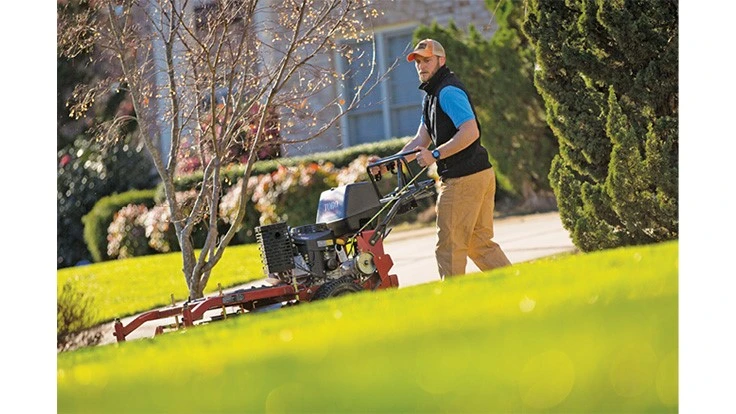
For all of these reasons, the walk-behind plays an important role in a company’s arsenal of equipment – whether you’ve got a few mowers or 40. Ben Wright, director of field operations at Canopy Lawn Care in Raleigh-Durham, North Carolina, has a staff of 75 and services only residential lawns. “So, our setup is a little different,” he says.
Sixty percent of Wright’s fleet consists of walk-behind mowers. That includes a range of 21-, 36- and 48-inch deck machines. His company also operates 36- and 48-inch stand-on mowers. No matter what he’s buying, the top priority is quality of cut.
Walk-behind mowers come in a range of sizes, operator controls and engine configurations. So what should you consider before making a purchase?
Which walk-behind?
When it comes to engines, both hydrostatic and belt-drive transmissions both have their benefits. Alex Calle, owner of Two Brothers Landscaping in Parsippany, New Jersey, generally goes for hydrostatic walk-behinds because of their instant-turning capabilities. “The maneuverability is night and day compared to a belt drive,” he says.
That said, Calle has 36-inch belt-driven walk-behinds in his fleet because they are more cost-effective in that deck size. “We don’t use the 36-inch mowers too frequently – only in areas where we can’t fit a 52-inch walk-behind,” he says.
Wright likes hydrostatic mowers because of their efficiency. “You can really turn better, and you don’t get scuff marks on the lawn when you turn,” he says. Most of his walk-behinds are hydrostatic, however he does have belt-drive mowers for flexibility.

Photo courtesy of Canopy Lawn Care
He likes to have a variety of walk-behind mowers with different control configurations. “What I’ve learned is, we have employees with different experiences in the field using different mowers, so they are comfortable with certain controls,” Wright says. “I like to have a variety in our fleet to cater to the operator. If you have happy employees who can run a machine without thinking about it – almost as if it were another member of their body – you gain efficiency.”
And having different mowers doesn’t cause a problem with getting parts because of his vendor’s selection, Wright says.
Accessibility of parts and dealer support are key factors Calle weighs into any mower purchase, including the 15 walk-behinds in the fleet at Two Brothers. “Price point is important also, and we go with brands that have been out there for a long time,” he says.
Walk-behind analysis.
Deck size is one benefit of walk-behinds because they can fit into spaces that some ride-on and can’t.
“Being primarily residential, we have routes where the majority of properties have fenced-in back yards,” Wright says, noting that the gates are often too small for a 48-inch deck.
In fact, Wright builds routes based on mower type and size. That way, he can group machines in a trailer, saving crews time switching back and forth between mowers.
“I like to have a variety (of mowers) in our fleet to cater to the operator.” Ben Wright, Canopy Lawn Care
At Two Brothers Landscaping, large area walk-behind mowers with 52-inch decks handle wide open properties. Aside from the generous walk-behinds, the company also has 20 40-inch stand-on mowers. “But, they are not too good on hilly terrain, so that is when we use the walk-behinds,” Calle says.
Because half of Calle’s walk-behinds are equipped with sulky attachments, his crews gain the operator efficiency that stand-ons offer. Not to mention, the sulkies prevent fatigue. But, walk-behinds aren’t always the best machine for the job. “With our stand-ons, the mower layout allows the operator to see straight down over the area they are mowing, whereas that visibility can be taken away when using a walk-behind mower,” Wright says.
On the other hand, walk-behind mowers shine in tricky lawn layouts. “On technical areas with lots of tight, small, curvy areas and sloped terrain, our operators can take their time with the walk-behind and they almost have to pay more attention to where they are going,” Wright says.
Ultimately, the key is to have options, which is why walk-behinds complement stand-on, ride-on and zero-turn mowers.
Wright’s three-year old company has been acquiring equipment regularly to keep pace with growth. “We like to keep a variety because it gives our operators flexibility,” he says.

Explore the March 2019 Issue
Check out more from this issue and find your next story to read.
Latest from Lawn & Landscape
- Bobcat Company debuts MT120 mini track loader
- Senske Family of Companies opens new corporate office
- Autonomowus Lawn Company adds robotic mowers to Genan tire recycling plant
- Visterra Landscape Group acquires Cleveland-based H&M Landscaping
- SiteOne names Carrothers VP of agronomic business development
- Batman and business
- Ever-changing landscape of SEO
- Fleetio acquires Auto Integrate, raises $450M in Series D funding






